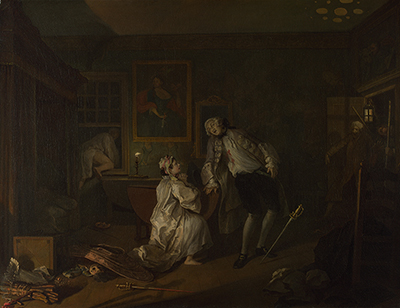The Bagnio is an oil on canvas painting that was executed by the English painter William Hogarth in 1743. It's the 5th picture in the series of 6 satirical paintings called Marriage A-la-Mode.
The Bagnio measures 27.5 in × 35.7 inches and is housed in the National Gallery in London. In the painting, the new Earl has caught his wife cheating with her lover, Silvertongue. The bed is unmade, which indicates that he has found the couple together in bed. The scoundrel has fatally wounded him while escaping through the window. After bursting in, the Earl had a sword fight with her wife's lover. Silvertongue took advantage of his opponent by fighting with the light he took from the fireplace. There is a mirror hanging on the back wall framing the Earl's head, a reference to the scene where the young Viscount is admiring himself in the mirror.
In the foreground, Silvertongue's bloody sword is lying on the floor. The Earl has been stabbed twice, and he's dying from the wounds. The Countess is pleading with the Earl to forgive her. The artist provided a partial view of Silvertongue's genitalia while he is escaping, reminding viewers how ridiculous the circumstances of his wife's plea for forgiveness is. The episode occurs in the Turk's Head Bagnio, and this was in Bow Street, a thoroughfare situated in Covent Garden, Westminster. This can be identified by the bill seen on the floor by the overturned table on the left. The upturned piece of furniture is a device that William uses to indicate discordance and disagreement. Among the wreckage, there are drops of mercury, which is a treatment for syphilis.
Bagnio was originally a term used to refer to a coffee house that was offering Turkish baths; however, by William's time, it meant a place where rooms were taken for the night without asking questions. On the back wall, there is a painting of an idealised shepherdess that has the face substituted with that of a popular prostitute. Below this painting, there is a pair of funny legs that belongs to a character who is in the tapestry behind; however, they appear to be the shepherdess' legs. William's works greatly influenced John Collier, also known as as the "Lancashire Hogarth". The artist also influenced a lot of caricaturists of the eighteenth, nineteenth and twentieth centuries. William's influence lives on today and many artists draw inspiration from his work.




